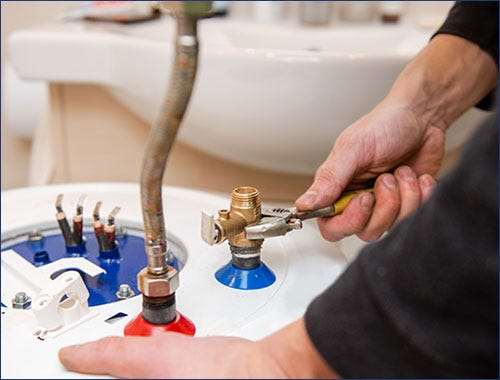Your water heater is likely the most critical part of your properties plumbing system. A adequately maintained heater can last from ten to fifteen years or far more. But, a heater not correctly maintained can fail in 4 to six years. The condition of the drinking water in your area and the location of the heater in your dwelling are out of your manage, but right maintenance of the heater and your plumbing technique is vital to heater longevity and safety.
This report offers you a list of items to verify for each tank form and tankless water heaters. As you go via the steps in checking your heater, if you have the slightest doubt in your capacity, get a professional, licensed plumber involved! You are dealing with hot water, organic gas, and electricity!
Tank Sort Water Heater Upkeep:
Vent (Gas Water Heaters Only)
The vent should be the exact same diameter as the draft diverter on the heater tank.
The vent should really go usually “up and out” the ceiling.
Exactly where is passes by way of the exterior wall, the vent should be double-walled.
Vent sections need to be screwed collectively with a minimum three screws per section.
Note: Undesirable vent pipe connections can fall apart and lead to carbon monoxide poisoning, the silent and deadly gas!
Temperature & Stress Relief Valve (T&P Valve)The T&P valve is designed to protect against the heater from exploding if the water pressure or temperature exceeds safe limits.
Pull up the manage on the valve and water really should flow out and cease when you let go of the deal with.
The T&P valve has a drain line that ought to go down to about six” from the floor or be plumbed outside your residence.
Note: Water leaking out of a T&P drain line can signal a poor T&P valve, higher water stress, or a malfunctioning thermal expansion device.
Water Stress (All Water Heaters)
Water pressure over 80 pounds per square inch (psi) can harm heaters and your piping. It can also damage plumbing appliances, toilets, and your fixtures.
Note: One giveaway that your have high water pressure is when the T&P Valve on the heater starts opening and closing.
Outer Water Heater Metal Shell & Plumbing Fittings
Inspect the heater outer sheet metal shell for leaks or rusting.
Inspect the plumbing fittings on the heater for corrosion, rust, or water spotting.
Note: Rusty fittings or discolored shell is a telltale sign that a leak is present!
Temperature Handle
Inspect the heater temperature handle dial to insure its set at the right water temperature.
The perfect water temperature is 120° Fahrenheit.
Note: Anything above 120° Fahrenheit greatly increases scalding danger, energy use, and sediment build-up in the bottom of the heater!
Combustion Chamber (Gas Water Heaters)
Turn the gas valve handle to “pilot position”.
Eliminate the outer access hatch or cover on the side of the heater.
Inspect the roof of the chamber for heavy rusting, water marking, or pitting.
Return the gas valve handle back to the “on position”.
Note: Black soot in the combustion chamber means drafting troubles, combustion problems, fume issues, and a fire hazard!
Pedestal Base (Gas Water Heaters)
Make confident the pedestal base the heater rests on is steady and supports the unit.
The standard pedestal will preserve the bottom of the heater at least 18″ off the floor.
Note: A newer water heater may have a “filtered combustion chamber” that is supposed to resolve the want for a pedestal. Check the owner’s manual for your heater.
Drain Valve
Open the drain valve to insure that mineral sediment, anode sludge, or rust has not clogged your heaters drain.
Drain Overflow Pan
If your heater is on the 2nd floor above living space it should have a drain pan.
The drain pan need to be plumbed to the outdoors of your home.
Inspect the condition of the drain pan, fittings, and piping to the outside.
Corrosive Fumes (Gas Water Heaters & Tankless Water Heaters)
Water heaters draw air in for combustion and the good quality of the air is crucial.
Corrosive liquids, ammonia, or acids stored close to a heater can lead to corrosive air.
Note: Corrosive air drawn into the burner can prematurely corrode the heater.
Internal Tank Corrosion and Rust-The internal tank of your heater is constructed of steel and glass lined to stop rust. Sacrificial anode rods are installed in the tank to safeguard the glass lined internal steel tank from rust. Aluminum/Zinc or magnesium anode rods corrode over time and get used up through an electrolytic course of action.
Note: Replacing the anode rod can extend the life of the heater but, should be done by a trained, experienced service technician.
Sediment Construct-up-Sediment is designed when tough water is heated. The make-up of sediment in the bottom of the tank can lead to the bottom to overheat and melt away the glass lining of the tank. It can drift into recirculating lines, jam open verify valves, and trigger the recirculating pump to stick till it burns out. Sediment construct-up on the bottom of gas water heaters encourages noisy operation. The noise is triggered by little amounts of water beneath the sediment layer turning into steam bubbles, which then collapse violently.
Note: tankless water heater Riverside CA create-up can reduce the energy efficiency of the heater and void the warranty on some Residential Water Heaters!
Tankless Water Heater Maintenance:
Flushing-Most tankless water heater manufacturers advocate flushing the whole unit every single six months to 1 year depending upon the water good quality. Reference your manufactures recommendation for flushing. Flushing the unit often removes any mineral deposits (generally calcium or lime) that may possibly have built up inside the boilers. Manufacturers advise utilizing a utility pump to circulate three or 4 gallons of vinegar or one more low-grade acid for 45 minutes to clean out any deposits.

